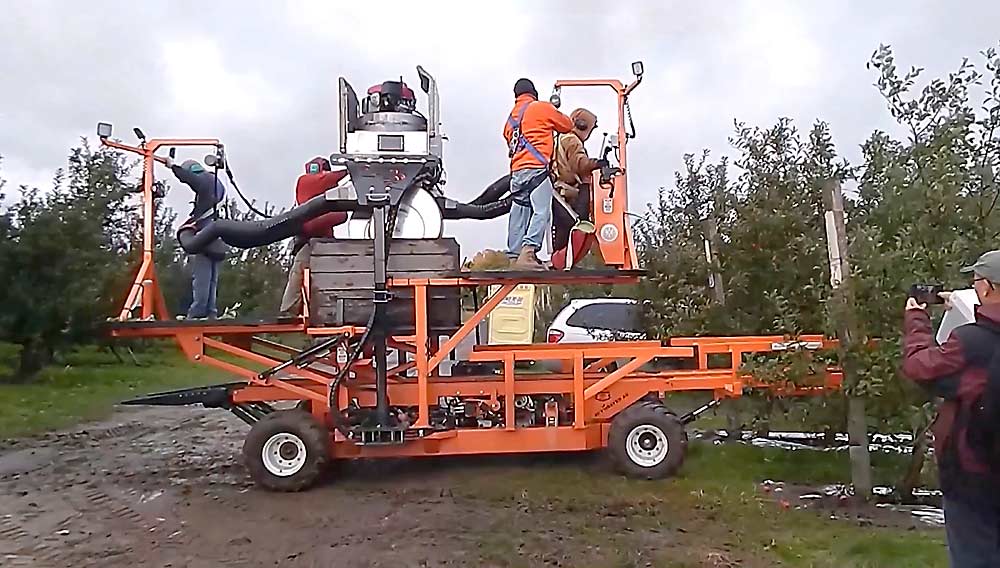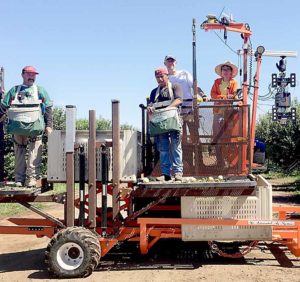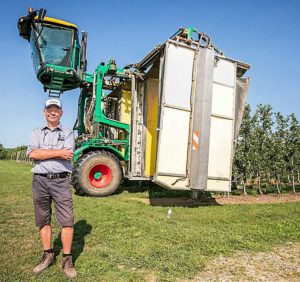
When Penn State University researchers conducted trials comparing harvest efficiency of platforms to ladders, platforms were more efficient.
No surprise.
But Long He and Daniel Weber noticed something else: The pickers in the front picked more than their partners behind them, even when positioned at different heights and given different zones.
“We think this is because they are trained to pick everything in reach as quickly as possible when using ladders,” said Weber, a tree fruit extension educator based in Adams County. “The consequence of this was that there were occasions where the rear picker had no fruit to pick, or so few that his harvest efficiency was significantly diminished.”
Weber and He, a bioengineering professor, tabulated the data. In a Michigan trial, where the two visited to watch the Cyclone prototype, the rear picker collected 0.59 apples per second compared to 0.71 for the front picker. The Cyclone is a vacuum harvest-assist system mounted atop a Bin Bandit platform.
In a Pennsylvania test with a Bin Bandit platform alone, the difference was smaller. The rear picker picked 0.72 apples per second compared to 0.73 for the front worker. That may not sound like a lot, but stretched out over a 40-hour week, it adds up to 1,440 more apples for the front worker. That’s about two-thirds of a bin for 100-count-size apples, according to an Ontario government website. Still not a huge difference, but it does add up.
Weber recommends growers mitigate this risk of imbalance by visually delineating picking zones or speeding up the platforms a little.
They plan to study the effect, and best solutions, in more detail after the Penn State Fruit Research and Extension Center in Biglerville gets its own platform this year, said He.
“This is based off just a few days’ worth of observations from only two crews in two locations,” Weber said.
Weber and He are not the only ones to notice this platform effect. Looking for a technological solution, a research team at the University of California, Davis, developed a prototype platform that uses computer vision to automatically position the picking stations vertically as the machine creeps down the rows.
Orchard managers throughout North America just manage around the discrepancy.
“Yes, we do notice this,” said Juan Cuevas, regional manager for Stemilt Growers’ Mattawa, Washington, operations. Of the 2,300 acres under Cuevas’ watch, 1,200 are picked by about 40 platforms.
It’s not a big problem, though, he said.
He solves it by instructing pickers to work within zones delineated by trellis wires, 22 inches apart, and simply rotating the workers on platform positions to spread out the fatigue.
The company’s pay structure is hourly plus performance bonuses for each crew, so no single worker has an incentive to hog the fruit.
“We try to divide the zones, and we try to make them fair,” Cuevas said.
At Blue Mountain Fruit Co. near Thornbury, Ontario, roughly two hours north of Toronto, workers pick from eight platforms that only have one level, and managers expect workers to pick at different rates, said Gerbe Botden, orchard manager.
The platforms, built on the farm, carry a crew of four — one of them designated as a crew leader and driver. He positions the more experienced, faster pickers in front.
Supervisors watching the platforms encourage drivers to increase their speeds until the front two pickers are gathering about 60 percent of the fruit. That leaves the remaining 40 percent, often more hidden by branches and harder to reach, for their partners in the rear. That’s the efficiency sweet spot in their experience, Botden said.
If they find the front pickers collecting more than that, the back pickers tend to reach too low for fruit that would be better left for ground crews. That means the crew leader needs to speed up the platform.
“It’s just about training,” he said.
Staffing each platform with only two workers would make each platform more efficient, but the capital investment doesn’t pencil out for the farm, so they stick with four.
Management of the tree architecture makes a bigger difference than the pacing of the workers, Botden said. Harvest efficiency comes from uniform fruiting walls with consistent cropping.
“If it’s an inconsistent orchard … that’s when you run into issues,” Botden said.
—by Ross Courtney








Leave A Comment